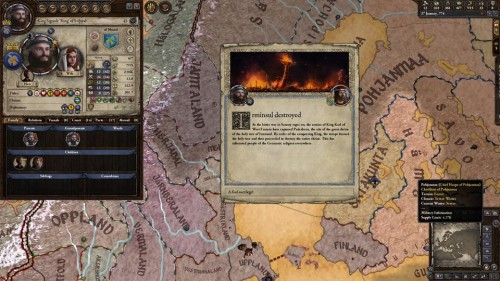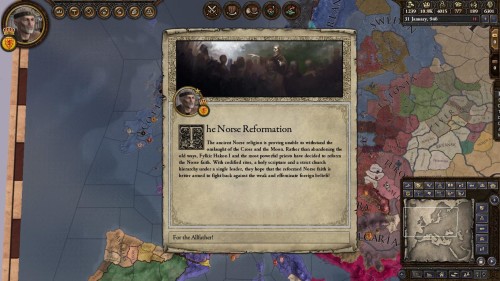The message arrives in Uppland, news from Theodric’s lands far to the south: the Irminsul has been destroyed, burned to ashes by the demon Charlemagne. The implications become clear – this latest pillaging of one of the Heathen faith’s sacred sites foretells the fall of Saxony into King Karl’s burgeoning empire, and a crippling blow to the power and influence of the gods of the north. I look to to my own lands, to the grand temple at Uppsala within my capital; like the Irminsul, this temple represents one of the faith’s strongholds. Could Charlemagne’s armies strike so far into Scandinavia? Could Sviþjod withstand that which Saxony could not? Is there any way to forestall the coming of Charlemagne and his White Christ?

Charlemagne destroys the Irminsul in a special event from Crusader Kings 2.
This scenario races through the mind of the Jarl of Sviþjod, Sigurðr “Ring,” otherwise known as, well, me. I am playing a computer game, Crusader Kings 2. Despite the name, the game is less about the Crusades themselves and more about simulating the history of medieval Europe (and, as time goes on, many other parts of the world) during the period from the late 8th century to the middle of the 15th century.
The game is not so much to look at – graphically, it consists of a map and some pop-up windows detailing character traits and geographic features – but despite this, I have logged more than 300 hours playing it in the past 14 months. Although it features no voice acting, no elaborate plot beyond the inevitable march of history towards the modern era, and one of the steepest learning curves I have ever encountered in a computer game, Crusader Kings remains a compelling, immersive experience for me.
In Crusader Kings, the player takes on the role of a ruler in the Middle Ages – anything from a count, in control of only one province, up to the rulers of the continent-spanning empires of Byzantium and the Abbasid Caliphate. These rulers are mostly the historical figures known to have been in place at the time; at the start of the game, the map reflects an attempt at mirroring the actual geopolitical makeup as well as it can mirrored. But as soon as the player unpauses the game, history begins to change, as the AI immediately starts to take its characters in directions never borne out by the record. The player, of course, shapes the course of events to an even greater extent, given that the player can pursue a more elaborate strategy than the AI.
In time, the player’s character will grow old and die (or die in any number of other ways – it is the Middle Ages, after all), and the player takes on the role of their heir. Over the course of the centuries, the player will experience many generations of their rulers’ family line, guiding them to fame or ruin. There is no “goal,” so to speak, beyond a perfunctory points counter; the game relies on the player to develop their own goals, whether that be conquest, dynastic prestige, or serving as a loyal vassal to a more powerful ruler.
Now, a confession that should not surprise many: I almost always play pagan characters. By the time periods found in the game, Christianity and Islam have entirely eclipsed the classical pagan religions of the former Roman Empire, but the Germanic, Malian, Sámi, and Slavic peoples, among others, retain their historical pagan religions. And for me as a modern Pagan player of Crusader Kings, the option to play as a historical pagan draws me deep into the game.
Mechanically, Crusader Kings 2 simulates religion in a fairly deep way, certainly in comparison to other strategy games like the Civilization series. Religions have unique characteristics that result in distinctive play styles – Catholics, for example, must deal with the Pope and the church hierarchy. Unfortunately, most of the pagan religions in the game are fairly generic and interchangeable, with the exception of the Germanic religion, which has a number of special features. (Vikings get to have all the fun, as usual.) Pagans are also more susceptible to conversion by other religions, with the intention that, ultimately, the game will follow history and see the domination of the map by Christian religions. The only way to forestall this fate is for the pagan religions to “reform” themselves, adopting some of the features of the revealed religions and setting up a centralized hierarchy. Reformation is not an easy task to accomplish: a single ruler has to control a number of holy sites, many of which may be in the hands of other religions, and the religion itself must have a certain amount of “moral authority,” representing how well it stacks up against the challenges presented by other, competing religions.

A ruler reforms the Germanic faith, installing himself as a Pope-like Fylkr, in Crusader Kings 2.
Obviously, there is much to critique about this game system from a historical perspective. In the example with which I began, the Germanic holy site of Paderborn, site of the Irminsul, was lost to Charlemagne, an event which causes the Germanic faith to lose a large amount of its moral authority, making Germanic pagans more liable to convert to Christianity and making it more difficult to reform the religion. But it’s hard to imagine that Sigurðr up in Sweden would have even known the Irminsul existed, much less that its destruction would have such colossal consequences for the Germanic religion as a whole. The mechanics for reforming the faith demand an empire that would have been logistically impossible in the 9th century, as well. The game can also be critiqued for its assumption that the only way for a religion to thrive is to have a hierarchy and a central text; all successful religions, in other words, must mimic the Abrahamic faiths just to survive.
But in playing, I happily adjust to these mechanical demands. I build my unreasonable Viking empires and declare myself the Fylkir, head of a paganism that will not succumb to Charlemagne or his successors. The beauty of Crusader Kings is less that it accurately models history and more that it allows us to reimagine history as it might have been. We can sublimate ourselves into other identities and build a world that is different to ours. Some of the features of that world irk me; the Germanic religion, for example, focuses too much on the warrior-cult image of Norse society, and the Great Blot event focuses far too much on human sacrifice for comfort. But still. Think of it. A world without Olaf Tryggvason or St. Olaf. A world without Thorgeir Thorkellson’s fateful decision at the Althing. A world where ancient paganism survives the demon Charlemagne and his progeny. Even being aware of its flaws -– and there are many -– it’s an appealing idea, and in the game, it’s a world the player can achieve.
As a teenager, I spent a lot of energy worrying about the question of history: why did they win? “They,” of course, being the non-Pagan world, the conquerors, the crusaders, the inquisition. It was not a very sophisticated way of thinking about history, looking back on it, but it still rattled around in my head for many years. The answer, in the end, is “lots of reasons, and maybe they didn’t ‘win’ at all.” Playing this computer game doesn’t answer that question, of course. But playing in the guise of a historical pagan and working to create a different world from the one we have is cathartic, in its way, and the allure of this world-that-could-have-been is enough to keep me staring at the map on my screen for many hours to come.
The Wild Hunt is not responsible for links to external content.
To join a conversation on this post:
Visit our The Wild Hunt subreddit! Point your favorite browser to https://www.reddit.com/r/The_Wild_Hunt_News/, then click “JOIN”. Make sure to click the bell, too, to be notified of new articles posted to our subreddit.
The Protestant Reformation was basically a war to a draw between competing flavors of Christianity. What would a Norse Reformation look like?
Pardon, but there was just a bit more to it than that.
Among other things, the Protestant Reformation helped lay the foundation for the separation of church and state and moved Western Civilization away from the idea of a catholic (universal) church.
You’re quite right, I was talking about the war-game aspects. Hm, a Norse Reformation would likely introduce the idea of a universal church.
*grins*
It might at that. Any culture with gods who wander around in disguise will probably welcome strangers and consider hospitality holy.
At least it can be played on Linux.
Look Erik, you need to form a huge fleet and warriors and go burn the Vatican. Remember they have all the loot from all the Pagan Temples they have destroyed, so there is plenty for everyone. [Grin]
One in fifty people in France and Germany are directly descended from Charlemagne, and anybody who is descended from any European nobility. If your a descended of Charlemage, you are descended of Charles Martel, otherwise Charles the Hammer, who drove the moors out of France. In addition, to Frankish royal line, and four Roman Emperors.
I was a few decades away from conquering the known world in CKII with a Norse Empire. I’d beaten back the Mongolian Hordes and was overtaking the last remnants of the Islamic Empires in the Middle East. There were literally no Christian lands left in the world and a dwindling Islamic presence. Sadly I downloaded a DLC that corrupted my save file and I lost 200+ hours of work. CK II is a great game, and it was interesting to play on the concept of a Heathen religion surviving and spreading throughout the world, though part of me sees such a thing as anathema to the world accepting diversity of the Heathen worldview.